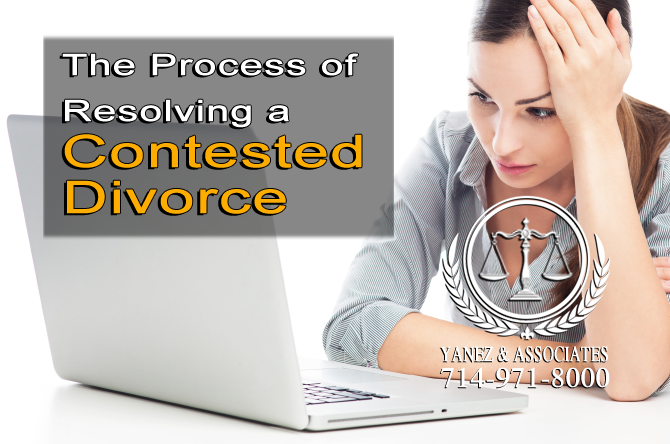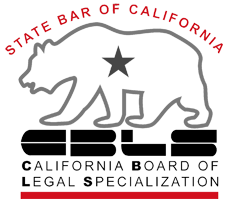Contested Divorce: Orange County Contested Divorce Lawyer
What is a Contested Divorce in Orange County, California? When a divorce is considered to be contested by the court, it means that the respondent, the person who was served with divorce papers, disagrees with the petitioner, who filed the initial divorce papers, about their proposed divorce agreement, AND that they filed papers with the court stating that they disagree with this proposal. Couples in contested divorces do not have a signed divorce agreement.
There are several ways that a divorce can be contested; in fact, there are four main ways that any divorce in California can be handled once the initial petition has been filed and 30 days have passed since the respondent was served. (The respondent has 30 days from being served divorce papers to file a response with the court before the petitioner can take action.)
A contested divorce does not necessarily mean that you and your spouse or partner cannot agree on anything in your divorce, it simply means that there is at least one topic that you do not have an agreement for.
In a divorce in California, there are four things that you and your partner or spouse will need to have an agreement for:
• The division of your community property and debt,
• Spousal support,
• Child support, and
• Child custody and visitation.
Why is My California Divorce Contested?

When one spouse or partner files a divorce petition in California, the other party, called the defendant, has several options for how to respond.
Three of these situations would be considered uncontested and one would be contested.
When the petitioner files the divorce petition, the respondent can either file a response, or not file a response.
Uncontested Divorce Situations
True Default - If the respondent does not file a response within 30 days of being served divorce papers and the two spouses do not have a divorce agreement outside of the courts, the petitioner will likely receive a default judgment. This situation is called a “true default”, and because there is no argument from the respondent, it is considered an uncontested case.
Default with Agreement - If the respondent does not file a response within 30 days of being served divorce papers, and the two spouses do have a divorce agreement, the two parties can submit the agreement without the respondent’s response. However, this is technically a default judgment because the respondent never filed anything with the court. This is considered an uncontested case because the respondent did not file a legal response stating that he or she disagreed with the petitioner.
Stipulated Judgment - When the respondent does file a response to the initial divorce petition, but the two parties have a written, notarized divorce agreement, the divorce is considered uncontested because the parties do not disagree on the terms of the divorce.
Contested Divorce Situation
When the respondent files a response with the court, but the two parties do not have an agreement regarding all aspects of the divorce, the case is considered to be contested. Remember that even if you can agree on some aspects of the divorce, if there is any part of the divorce agreement that is incomplete, the divorce is still contested.
In a contested case, the parties will need to choose a method to resolve their issues. Any form of alternative dispute resolution is always encouraged except in those cases that involve domestic violence or abuse.
Setting the Terms of a Contested Divorce in California
If you and your spouse or partner cannot agree on the terms of your divorce outside of court on your own, consider a form of alternative dispute resolution.
Alternative dispute resolutions are ways for you and your spouse or partner to set the terms of your own divorce with the help of a professional. There are numerous benefits to these alternatives to divorcing in a courtroom.
There are two main types of alternative dispute resolution: divorce mediation and collaborative divorce.
Divorce Mediation
If you and your spouse or partner choose the route of divorce mediation to resolve your divorce, you will first need to hire a divorce mediator. Divorce mediators in California are specially trained, and may also be attorneys, or retired professionals from either the legal field, or the mental health field. These professionals have a unique background, that when combined with their training enables them to help you resolve the issues that you and your spouse or partner may have.
The mediator may meet with each of you separately in order to gain an understanding of what you and your spouse or partner both want out of your divorce agreement. The mediator’s main job is to remain neutral and to facilitate a healthy discussion between you and your spouse or partner so that the two of you can work through your issues and create a divorce agreement to submit to the judge for approval.
It is advised that both parties consult an attorney outside of mediation, because neither party is allowed to have an attorney present during mediation.
If both parties cannot come to an agreement on all of the terms of the divorce, they may bring the remaining issues to court. For example, if the couple can agree on property division and spousal support, but cannot come to an agreement on child custody and visitation, or child support, they may opt to have those issues resolved in court.
Collaborative Divorce
Collaborative divorce is another way to resolve the issues present in a contested divorce, although it is generally less common than divorce mediation. Generally, a collaborative divorce is used before either party files for divorce, with the goal of an uncontested divorce.
However, it can be used in a contested divorce to resolve the issues between the parties. In a collaborative divorce, both parties hire divorce attorneys who are trained in collaborative divorce. Generally, the difference between a collaborative divorce and a litigated divorce is that the attorneys aim to help the parties work together to create a compromise, rather than working against one another as is usually encouraged in a litigated divorce.
Each party can meet with his or her attorney separately, and the parties will meet together with their lawyers until a resolution is found.
Usually, both parties agree that neither will file paperwork with the court unless both parties have agreed to it. If both parties do agree to take the unresolved issues to court, they usually also have an agreement that both parties will need to hire new lawyers for trial.
Benefits of Alternative Dispute Resolution
While trial is an option for resolving your contested divorce, it is usually used as a last resort. Alternative dispute resolution usually requires that the parties are on decent terms, or want to work towards being on good terms with one another.
However, choosing alternative dispute resolution, if you can, can offer numerous benefits.
• Usually, alternative dispute resolution saves you money on your divorce.
• You have more control over the outcome of your divorce when you set the terms yourself, which litigation does not guarantee.
• Alternative dispute resolution allows you to take as much or as little time as you need, and to schedule your meetings based on your schedule, rather than the court’s schedule.
• Most people are happier with the outcome of their divorce when they choose the outcome. This also means that both parties are more likely to understand and follow the terms of the divorce once it is finalized.
The Process of Resolving a Contested Divorce

Regardless of how you and your partner or spouse set the terms of your divorce, they cannot be turned into a divorce settlement until a judge has signed off on them.
In a contested divorce, both parties will already have filed papers with the court.
Following either mediation or a collaborative divorce, you, your mediator, or your attorneys will need to create a divorce agreement that is signed by both parties and notarized. It is always advised that you have your lawyer look over your agreement before you sign it.
Once the judge approves your divorce agreement, your divorce can be finalized. Remember that at least six months from the start of your divorce need to pass before your divorce can be finalized in California.
Orange County Contested Divorce Lawyers

If you have questions about your impending divorce, it is always best to discuss your situation with a qualified Orange County divorce attorney.
A lawyer will be able to provide you with information about how the law applies to your unique situation. At Yanez & Associates, we offer free initial consultations! Contact us today to schedule yours.













